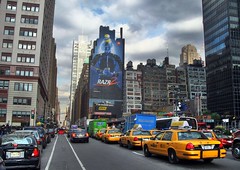Hanoi’s last blacksmith
From Seth Mydans’s “A Lone Blacksmith, Where Hammers Rang” (The New York Times: 25 November 2010):
HANOI, Vietnam — He is the last blacksmith on Blacksmith Street, dark with soot, his arms dappled with burns, sweating and hammering at his little roadside forge as a new world courses past him.
The son and grandson of blacksmiths, Nguyen Phuong Hung grew up when the street still rang with the sounds of the smithies, producing farm equipment, horseshoes and hand tools, before modern commerce and industrial production made them obsolete. “I still remember, when it was raining lightly, the streets were empty and that was all you could hear was the sounds of the hammers,” said Mr. Hung, 49.
…
The men who worked there left for lighter, better-paying work, and because the word was out that no modern woman would marry a blacksmith, Mr. Hung said. There may be other blacksmiths working in Vietnam, he said, but not here in the capital.
…
“Once I am gone the street will have no meaning anymore,” he said. “Blacksmith Street will be only a name.” That has been the fate of almost all the 36 narrow streets in Hanoi’s tree-shaded Ancient Quarter, each of them named for the guilds that once controlled them — Fan Street, China Bowl Street, Sweet Potato Street, Conical Hat Street.
There is nothing like this little corner of the urban past anywhere else in Vietnam. Only four of the streets have retained something of their original businesses, said Nguyen Vinh Phuc, a leading historian of Hanoi. There are still jewelry shops on Silver Street, sweets and pastries on Sugar Street, votive papers and toys on Votive Paper Street and pots and pans on Tin Street.
…
Traders have done business on this spot since the ninth century, Mr. Phuc said. The 36 guilds established themselves at the start of the 19th century.
…
Blacksmith Street got its name at the beginning of the 19th century, Mr. Phuc said, when French colonial administrators sent out a call for metal workers to help build the Long Bien bridge over the Red River. It was designed by the French architect Gustave Eiffel and became a target of American bombing raids during the Vietnam War.
Mr. Hung’s family has been here from the start, and like his father and grandfather he was called to help out around the forge when he was just a boy, as young as 6. But he rebelled and left for jobs as a driver and factory worker until, when he was 35, his father called him back. “My father told me this is the family trade and I’m the only one left to do it,” Mr. Hung said. “He said, ‘Just watch me work and you’ll learn what to do.’”
Mr. Hung discovered that he loved the work, and that it was his destiny to be a blacksmith. He remembered his father’s words: “When the iron glows red, you earn your money. That is your life.”
…
Mr. Hung has set up a little tea table on the sidewalk, refilling a thermos from a huge iron kettle that swings gently above the hot coals. A giant bamboo pipe leans against the table, and passersby are welcome to stop for a lungful of strong tobacco.
…
Mr. Hung hammers with the confidence of a master, bare-handed as he works because he says gloves would dull his touch. Wearing a pair of plastic sandals, he ignores the sparks that sting his feet and pepper his shirt with holes. Flames and smoke gush from the hot metal as he tempers it in a bucket of oil. By the end of the day, his arms and face are black with soot.
Hanoi’s last blacksmith Read More »
